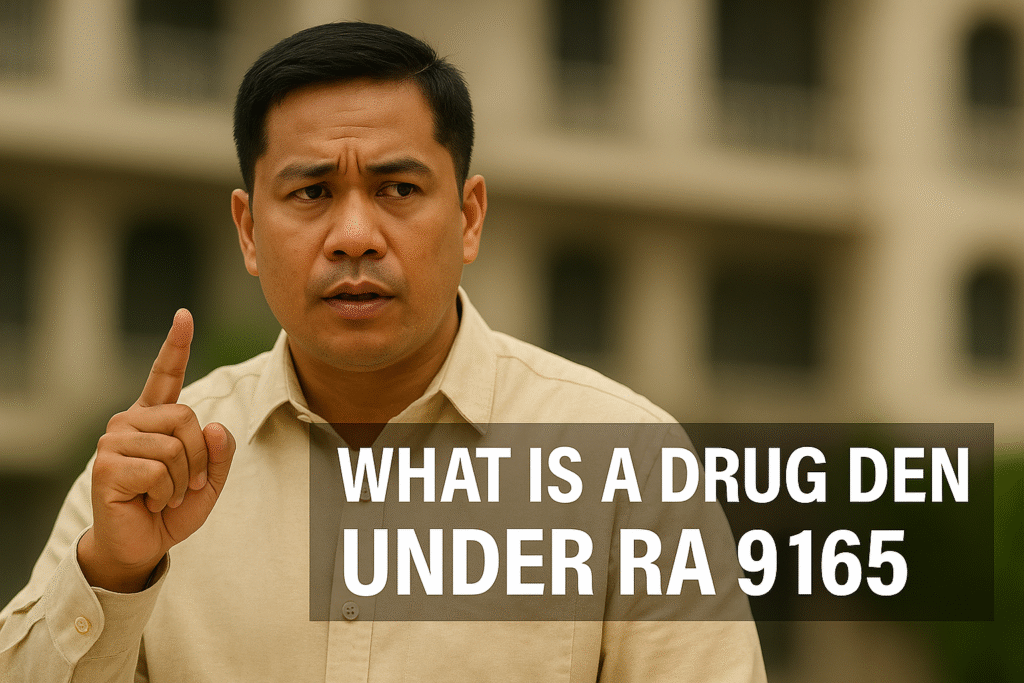March 4, 2022

A place where people are caught sniffing “shabu” or using illegal drugs does not automatically make that residence or place a drug den and that the person in charge of the same is guilty for maintaining a drug den as defined and punished under RA 9165.
In the case of People of the Philippines vs. Andanar and Garbo, G.R. No. 246284, June 16, 2021, the Supreme Court elaborated on the meaning of a drug den as follows:
For Garbo’s part, she was charged with illegal maintenance of a drug den under Section 6 of RA 9165. The offense requires the following elements: a) that the place is a den – a place where any dangerous drug and/or controlled precursor and essential chemical is administered, delivered, stored for illegal purposes, distributed, sold, or used in any form; and b) that the accused maintains the said place.
It is not enough that dangerous drugs or drug paraphernalia were found in the place. More than a finding that the dangerous drug is being used there, it must also be clearly shown that the accused is the maintainer or operator or the owner of the place where the dangerous drug is used or sold.
First, a drug den is a lair or hideaway where prohibited or regulated drugs are used in any form or are found. Its existence may be proved not only by direct evidence but may also be established by proof of facts and circumstances, including evidence of the general reputation of the house, or its general reputation among police officers.
People v. Galicia ordained that the prosecution must establish that the alleged drug den is a place where dangerous drugs are regularly sold to and/or used by customers of the maintainer of the den. The word “regular” means doing the same thing in uniform intervals, or something that is a common occurrence.
Here, PO2 Antillon, Jr. testified that Garbo invited him inside her house where the sale of illegal drugs between him and Andanar took place. Thereafter, Garbo offered PO2 Antillon, Jr. that he could already use the drug he just bought for an additional fee of P20.00. If at all, this only proves an isolated illegal drug transaction involving SPO2 Antillon, Jr., Andanar, and Garbo. There was nothing on record, however, showing that Garbo’s house was frequently used as a drug den. Neither did the prosecution prove that Garbo’s house had a general reputation as such. Surely, the prosecution had only presented a singular occurrence of the so-called illegal drug activity in Garbo’s house. The same does not satisfy the requirement in Galicia. Garbo, therefore, cannot be considered a maintainer of drug den. Besides, the supposed corpus delicti was not even established in view of the clear violation of the chain of custody rule, compromising its integrity.
Second, SPO2 Antillon, Jr. testified that while inside Garbo’s house, he saw Gutierrez using shabu, thus, making Garbo’s house a drug den.
We disagree. At the moment SPO2 Antillon, Jr. saw Gutierrez allegedly sniffing something, he only assumed it was shabu. More, nothing in the records show that Gutierrez underwent a laboratory examination and was found positive for drug use. Thus, the Court will not convict an accused, sans any supporting evidence. Mere assumptions or conjectures cannot substitute the required quantum of evidence in criminal prosecution. In any case, a single isolated occasion where one sees another person sniffing shabu inside a residence, even if true, does not automatically convert that residence into a den. The element of regularity is conspicuously absent.



